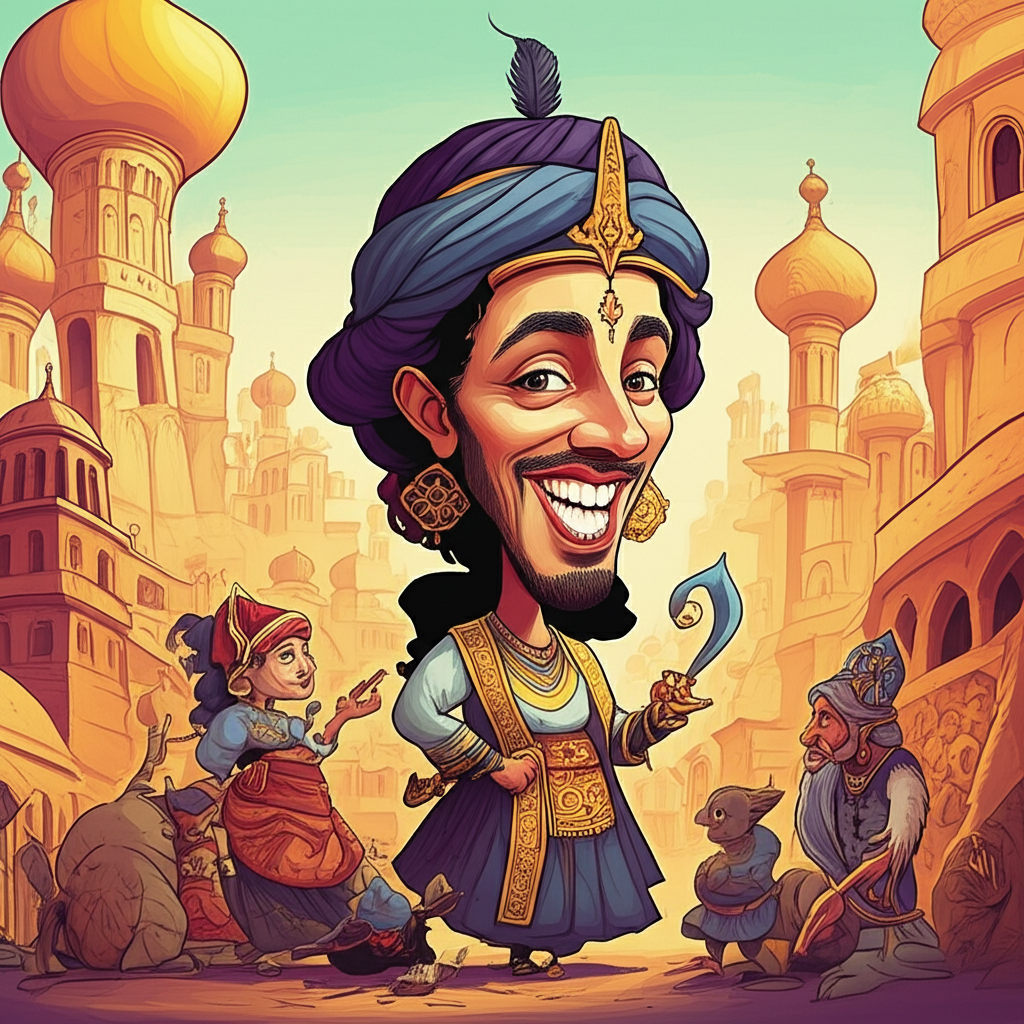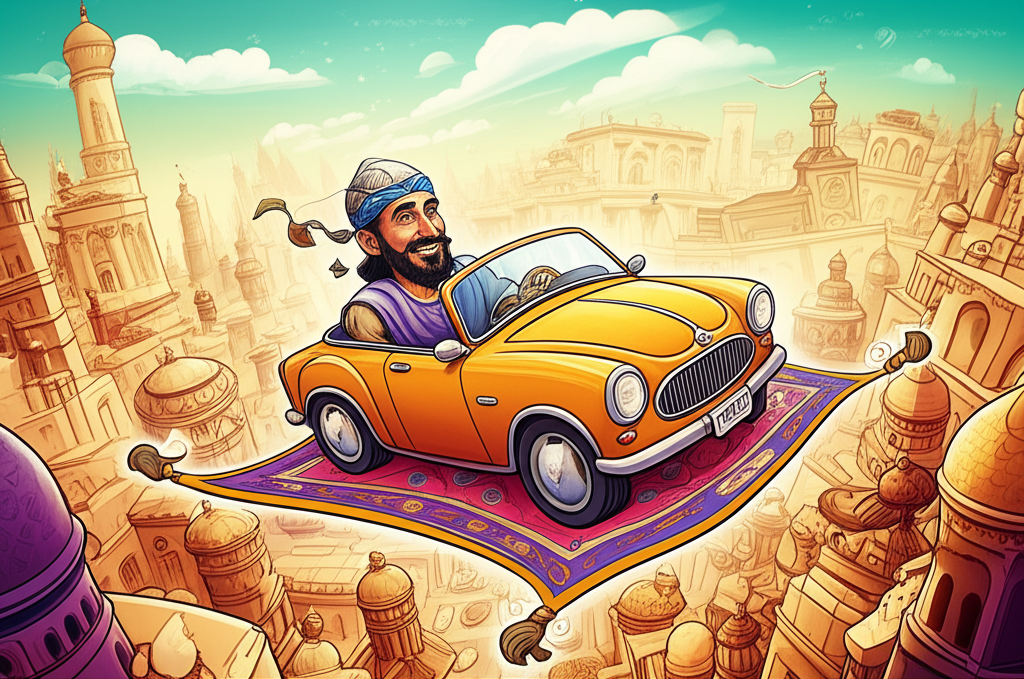
In the vast, sun-scorched landscapes of the Middle East, where sand dunes stretch to the horizon like waves of an ancient sea and the stars blaze with an almost tangible intensity, whispers of fantastical realms have long been woven into the fabric of human experience. Among these enduring tales is the legend of the City of Brass, a magnificent, yet perilous, metropolis said to lie hidden deep within the desert, a testament to the power and artistry of beings beyond mortal ken. This is not a historical account, nor a theological doctrine, but a vibrant tapestry of folklore, spun by ancient peoples to grapple with the mysteries of their world and the boundless potential of human imagination.
The genesis of such myths can be traced to a time when the world was a far more enigmatic place. In the pre-Islamic Arabian Peninsula, and indeed across much of the ancient Near East, life was intrinsically linked to the harsh realities of the desert. Water was a precious commodity, shade a sanctuary, and the scorching sun a constant, formidable presence. Societies were often nomadic or semi-nomadic, their lives dictated by the seasons and the availability of sustenance. In such an environment, the natural world was imbued with a potent spirit. The wind that sculpted the dunes could be a messenger, the shimmering heat haze on the horizon a mirage of both hope and deception, and the unseen creatures of the night capable of both great beauty and terrifying power.
This worldview fostered a rich tradition of oral storytelling, where myths and legends served as both entertainment and instruction. They explained the unexplainable, offered moral guidance, and provided a framework for understanding one’s place in a universe often perceived as governed by powerful, unseen forces. The City of Brass, with its ostentatious splendor and its inherent dangers, perfectly embodies this ancient perspective. It speaks to a fascination with extreme wealth and power, juxtaposed with a profound awareness of the fragility of human endeavors and the ever-present threat of the unknown.
At the heart of this legend lies the supposed architect of the City of Brass: a powerful, ancient entity, often described as a king or a jinn of immense stature and magical prowess. These beings, known as jinn in Islamic and pre-Islamic folklore, were believed to inhabit a parallel realm, invisible to humans but capable of interacting with the physical world. They were often portrayed as capricious, possessing immense power, and capable of both great good and great evil. The creator of the City of Brass was envisioned as one such being, perhaps a sorcerer-king who commanded legions of lesser jinn and spirits.
This mythical architect was said to have constructed a city of unparalleled beauty and technological marvel. The very walls of this city were not built of stone or mud brick, but of shimmering, molten brass, polished to a blinding sheen that reflected the desert sun with an intensity that could rival its source. Within its ramparts, it was rumored, lay palaces of exquisite design, adorned with jewels of unimaginable size and brilliance. Fountains flowed with perfumes and nectars, and intricate automatons, crafted from metal and magic, moved with an uncanny semblance of life, serving the city’s unseen inhabitants. This was a realm of pure opulence, a testament to a power and artistry far beyond human capabilities, a city that seemed to defy the very laws of nature by existing in the heart of the barren wasteland.
The narrative of the City of Brass often begins with its discovery, or more accurately, its attempted discovery by brave, or perhaps foolhardy, mortal adventurers. Tales speak of intrepid explorers, driven by greed or insatiable curiosity, who would venture deep into the uncharted desert, guided by cryptic maps or whispered rumors. They would endure blistering heat, treacherous sandstorms, and the constant threat of dehydration, all in pursuit of this legendary metropolis.
Upon finally locating the city, the accounts describe a breathtaking sight: the colossal brass walls gleaming under the relentless sun, a testament to its mythical creator’s power. However, this grandeur was invariably accompanied by a chilling aura of stillness and silence. The city, while magnificent, was often depicted as eerily deserted, its inhabitants vanished or in a state of suspended animation. The automatons might stir, their metallic joints creaking, but their movements would be devoid of genuine life.
The true peril of the City of Brass lay not in its initial appearance, but in the traps and guardians that protected its immense wealth. Ancient stories would recount how those who dared to enter would fall prey to cunning enchantments, illusions designed to lure them deeper into the city’s embrace, only to ensnare them. The very air might be laced with soporific fumes, or the ground might conceal hidden pitfalls. The automatons, initially appearing as servants, could transform into formidable sentinels, their metallic limbs striking with lethal force. The legend often served as a cautionary tale: the pursuit of excessive wealth or forbidden knowledge could lead to one’s downfall, turning dreams of riches into a permanent, desolate slumber within the gilded cage of the City of Brass.
The symbolism embedded within the City of Brass myth is multifaceted, reflecting the anxieties and aspirations of the ancient world. The brass itself, a lustrous metal, could represent immense wealth and power, but also the artificiality and impermanence of material possessions when divorced from true sustenance. The desert setting, a place of both hardship and spiritual introspection, highlights the stark contrast between the ephemeral allure of worldly riches and the enduring realities of life. The jinn architect, a being of immense but ultimately alien power, might symbolize the forces of nature that were both revered and feared, or perhaps the tempting but ultimately destructive aspects of ambition and hubris. The story could also be interpreted as a moral allegory, warning against the dangers of greed, the vanity of worldly pursuits, and the wisdom of respecting boundaries between the human and the supernatural.
In the modern era, the City of Brass continues to capture the imagination, transcending its folkloric origins to find expression in various forms of popular culture. In literature, it has been reimagined as a setting for epic fantasy novels, where its allure and danger serve as a compelling plot device. In video games, it often appears as a challenging dungeon or a lost civilization, its intricate puzzles and formidable guardians testing the skills of players. Films and television series have drawn inspiration from its mythical grandeur and its inherent sense of mystery, weaving its legend into narratives of adventure and discovery. Beyond entertainment, the City of Brass is also a subject of academic interest in cultural studies and comparative mythology, offering insights into the enduring human fascination with the extraordinary and the symbolic landscapes of ancient belief systems.
It is crucial to reiterate that the City of Brass is a product of rich cultural heritage and the boundless capacity for storytelling. It is a testament to the creativity of ancient peoples who used myth and legend to explore their world, their fears, and their aspirations. As Muslims, we understand that the true Creator and Sustainer of all existence is Allah (God) alone. The tales of the City of Brass, while captivating, are recognized as traditional narratives, not as factual accounts or divine revelations.
In conclusion, the legend of the City of Brass is a fascinating window into the minds of ancient cultures, a vibrant story born from the harsh beauty of the desert and the human desire to comprehend the unseen. It speaks of immense power, dazzling beauty, and the perilous allure of the unknown. While we appreciate the artistry and cultural significance of such narratives, we do so with a clear understanding that they are products of human imagination, offering reflections on morality, ambition, and the mysteries of the world, rather than claims of divine truth. The enduring power of these stories lies not in their literal truth, but in their ability to connect us to our shared cultural heritage and to remind us of the timeless human tradition of storytelling, a tradition that continues to shape our understanding and inspire our imagination.





